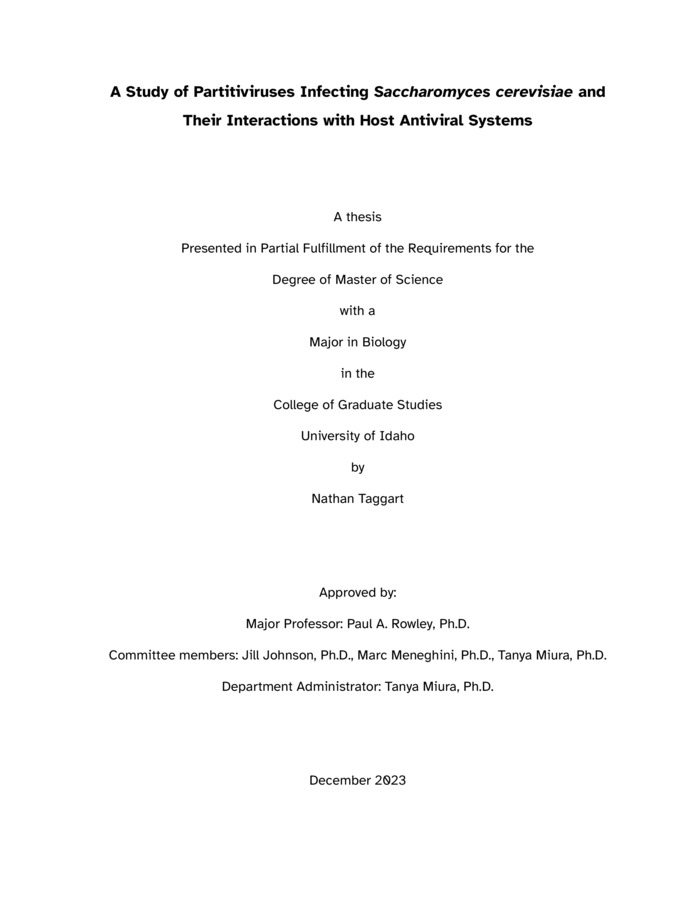A Study of Partitiviruses Infecting Saccharomyces cerevisiae and Their Interactions with Host Antiviral Systems
Taggart, Nathan. (2023-12). A Study of Partitiviruses Infecting Saccharomyces cerevisiae and Their Interactions with Host Antiviral Systems. Theses and Dissertations Collection, University of Idaho Library Digital Collections. https://www.lib.uidaho.edu/digital/etd/items/taggart_idaho_0089n_12745.html
- Title:
- A Study of Partitiviruses Infecting Saccharomyces cerevisiae and Their Interactions with Host Antiviral Systems
- Author:
- Taggart, Nathan
- ORCID:
- 0000-0002-6529-9264
- Date:
- 2023-12
- Program:
- Biological Sciences
- Subject Category:
- Biology
- Abstract:
-
Fungi are key components of the biosphere and serve key functions, such as aiding plant nutrient absorption and decomposing organic matter, yet these contributions coexist with significant threats, as fungal pathogens can cause extensive crop losses and endanger biodiversity. Mycoviruses are prevalent in fungal taxa and often coexist without apparent symptoms but can influence host physiology, impacting symbioses with other organisms, toxin production, and pathogenicity. Understanding these interactions holds promise for disease control and enhancing plant resilience.Partitiviruses (PVs) are double-stranded RNA (dsRNA) viruses from the family Partiti-viridae that infect plants, fungi, insects, and protozoa. They replicate within the cyto-plasm of their host and are transmitted by cell fusion and cell division. While many PVs are cryptic and have no apparent effects on their host, some cause altered morphology, reduced growth rate, and disrupted sexual reproduction in their fungal hosts. Some PVs infecting pathogenic fungi can reduce their virulence, such as in the Chestnut blight fungus Cryphonectria parasitica, while others cause hypervirulence, such as in the human pathogen Talaromyces marneffei. There have been a few studies investigat-ing how partitiviruses alter host physiology, but the family Partitiviridae is, by and large, understudied, and there is little to no understanding of how these viruses protect their genomes and transcripts from host surveillance mechanisms. A large factor in this knowledge gap is the lack of a robust model system. A large-scale screen aimed at revealing the dsRNA “virome” of the baker’s yeast Sac-charomyces cerevisiae identified three novel species of partitivirus and were named Saccharomyces cerevisiae partitivirus 1, -2, and -3. Notably, nearly all ScPV-infected yeast strains were isolated from coffee and cacao fermentations and carried ScPV1 and/or ScPV2. ScPV3 is found winemaking strains. ScPV infection was confirmed by sequencing the viral dsRNAs and subsequent purification and visualization of non-enveloped, isometric viral particles. The particles lacked any obvious protrusions that are characteristic of other PVs. The full genome sequences of ScPV1-3 were obtained by short-read sequencing and 5’ rapid amplification of cDNA ends. ScPVs have signifi-cant predicted secondary structure, which is hypothesized to play roles in packaging and replication. Phylogenetic analysis revealed that ScPVs are most closely related to Cryptosporidium parvum virus 1 (CSpV1), which infects the mammal-pathogenic pro-tozoan Cryptosporidium parvum. Models of the ScPV capsid protein (CP) and RNA-dependent RNA polymerase (RdRP) were generated and found to be structurally ho-mologous to those of other PVs. ScPVs demonstrate stability during laboratory cultivation and successful transmission to haploid progeny after sporulation. ScPVs were also horizontally transmitted by strain hybridization. These characteristics allowed preliminary study of interactions between ScPVs and host antiviral genes, such as the 5’-3’ exoribonuclease XRN1, NUC1, and the SKI complex/exosome. ScPVs are resistant to Xrn1 overexpression, and SKI2 deletion is associated with increased copy number, suggesting viral transcripts lack poly(A) tails. Sporulation of a SKI3/ski3∆ strain was associated with loss of ScPVs from all meiotic progenies. There is no obvious relationship between ScPV copy number and deletion of either NUC1 or SKI7. This work details the discovery of the first novel dsRNA viruses discovered in S. cerevisiae in nearly half a century. S. cerevisiae, a widely employed model organism for exploring diverse cellular mechanisms, including host-virus interactions, offers a unique opportunity to develop a novel model system to fill a knowledge gap in the un-derstanding of partitivirus biology.
- Description:
- masters, M.S., Biological Sciences -- University of Idaho - College of Graduate Studies, 2023-12
- Major Professor:
- Rowley, Paul A
- Committee:
- Meneghini, Marc; Johnson, Jill; Miura, Tanya
- Defense Date:
- 2023-12
- Identifier:
- Taggart_idaho_0089N_12745
- Type:
- Text
- Format Original:
- Format:
- application/pdf
- Rights:
- In Copyright - Educational Use Permitted. For more information, please contact University of Idaho Library Special Collections and Archives Department at libspec@uidaho.edu.
- Standardized Rights:
- http://rightsstatements.org/vocab/InC-EDU/1.0/

